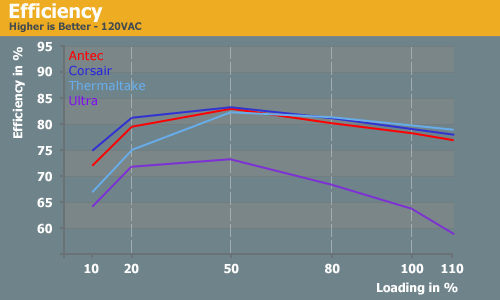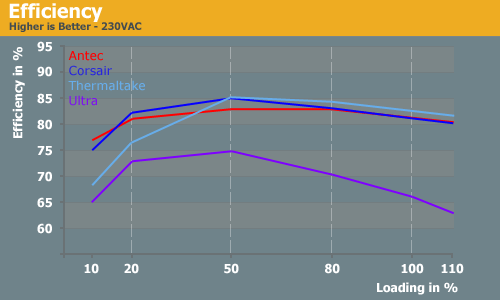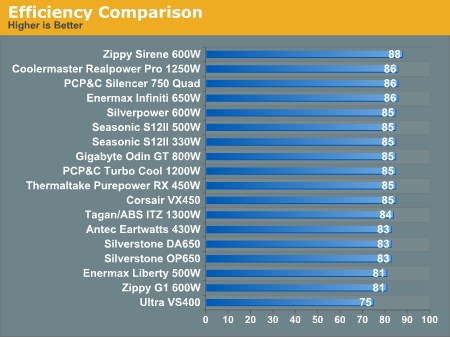400-450W PSU Roundup
by Christoph Katzer on November 6, 2007 4:00 AM EST- Posted in
- Cases/Cooling/PSUs
Comparison and Conclusion
Let's come to the interesting part of performance. The output stability has been quite similar from the three higher-end units. Thermaltake looks a little better than the others do, but all are well within specs. Ultra ends up as a very low-end unit and the results clearly show this better than any words.


In the area of efficiency, the Antec and Corsair units take the lead again. Both are at 80% efficiency starting with loads of around 90W while the two other are at 76% and 73%. The components in the Corsair PSU seem to be slightly better than the cost-reduced Antec PSU, as evidenced by the 1% higher efficiency. Still, 1% higher efficiency should not be the only reason for buying this unit since there are so many other points to keep in mind. Thermaltake does achieve a high 85% efficiency with a medium load of 225W as well.

In terms of connectors, the Corsair clearly has the most options and is the best-equipped PSU of the bunch. There are six Molex and six SATA connectors attached to four harnesses with a minimum length of 30cm and a maximum length of just 60cm. The ATX connector, PEG and CPU connectors have a length of 60cm as well which is nice and long. The corsair is the only unit today with an 8-pin EPS connector (not that it's really necessary for a 450W PSU).
When it comes to prices, it's no shock that the Ultra is the cheapest (by far!) of the four tested units, with prices as low as $40US. The V-Series 400W is not available in Europe because of the missing PFC. The Antec Earthwatts 430W comes next, with prices starting at $60. That may be 50% more than the Ultra, but we hope it's now clear that this is money well spent. Corsair and Thermaltake come in as the most expensive of this batch, with the Corsair 450VX selling for around $78 and the Thermaltake Purepower 450W going for a few dollars more ($84).
After looking at the test results, one of these power supplies clearly rises above the rest: the Corsair 450VX. It provided the best overall performance, it wins in the area of connector options (though not by a large amount), and it also provides the lowest noise levels. It's not perfect, as heatsink temperatures were still a bit higher than we'd like under stress conditions, but if you're after a high quality, moderate wattage power supply this one definitely ranks above the rest. The price is even acceptable. If you'd rather spend less than $60, while the Earthwatts isn't bad, we'd probably just go back to the source and pick up a Seasonic 380W unit.
Let's come to the interesting part of performance. The output stability has been quite similar from the three higher-end units. Thermaltake looks a little better than the others do, but all are well within specs. Ultra ends up as a very low-end unit and the results clearly show this better than any words.


In the area of efficiency, the Antec and Corsair units take the lead again. Both are at 80% efficiency starting with loads of around 90W while the two other are at 76% and 73%. The components in the Corsair PSU seem to be slightly better than the cost-reduced Antec PSU, as evidenced by the 1% higher efficiency. Still, 1% higher efficiency should not be the only reason for buying this unit since there are so many other points to keep in mind. Thermaltake does achieve a high 85% efficiency with a medium load of 225W as well.

In terms of connectors, the Corsair clearly has the most options and is the best-equipped PSU of the bunch. There are six Molex and six SATA connectors attached to four harnesses with a minimum length of 30cm and a maximum length of just 60cm. The ATX connector, PEG and CPU connectors have a length of 60cm as well which is nice and long. The corsair is the only unit today with an 8-pin EPS connector (not that it's really necessary for a 450W PSU).
When it comes to prices, it's no shock that the Ultra is the cheapest (by far!) of the four tested units, with prices as low as $40US. The V-Series 400W is not available in Europe because of the missing PFC. The Antec Earthwatts 430W comes next, with prices starting at $60. That may be 50% more than the Ultra, but we hope it's now clear that this is money well spent. Corsair and Thermaltake come in as the most expensive of this batch, with the Corsair 450VX selling for around $78 and the Thermaltake Purepower 450W going for a few dollars more ($84).
After looking at the test results, one of these power supplies clearly rises above the rest: the Corsair 450VX. It provided the best overall performance, it wins in the area of connector options (though not by a large amount), and it also provides the lowest noise levels. It's not perfect, as heatsink temperatures were still a bit higher than we'd like under stress conditions, but if you're after a high quality, moderate wattage power supply this one definitely ranks above the rest. The price is even acceptable. If you'd rather spend less than $60, while the Earthwatts isn't bad, we'd probably just go back to the source and pick up a Seasonic 380W unit.










37 Comments
View All Comments
Christoph Katzer - Tuesday, November 6, 2007 - link
Yep, otherwise it's just getting too long and I thought actually nobody is too interested in that analyses anyway. Let me work something out for the next ones...Ripple is also coming today, I updated the 1200-1300 roundup already.
Super Nade - Tuesday, November 6, 2007 - link
Good to know! I understand that it is going to take a considerable amount of work at the outset, to do a bit of design analysis, but once you have the popular topologies employed figured out it should be a lot less work.The length of the review is unimportant if it makes an interesting read. (Hypothetical example) Having 10 pages on the fans employed is going to be be boring. Since you have a wide audience with varying degree of technical appetite, the length of the review should not matter if the content is arranged appropriately.
Best wishes,
S-N
floffe - Tuesday, November 6, 2007 - link
When referring to the 8800GT article, it'd be nice to point out that those 327W from the wall was with SLI. A single card didn't get much over 200W, so even the Ultra should be able to run that, however horrible it otherwise is a a PSU.As for the market, I just wish someone would produce a high quality 300W modular PSU. That'd be plenty for my needs.
xsilver - Tuesday, November 6, 2007 - link
Would you be ok if they charged you the same as a 400w PSU? because for the manufacturers, they're not going to the trouble of making another PSU that costs them almost exactly the same to make.(its like asking for a car with only 15hp because thats all u need ;)
jonnyGURU - Tuesday, November 6, 2007 - link
Exactly. The cost difference at that level is rarely more than a $1. So if it costs me $30 to build a 400W, and $29 to build a 350W, etc. why would I bother?Souka - Wednesday, November 7, 2007 - link
maybe because some people "think" a 350w power supply consumes 50w less than a 400w power supply...:)
Hinkdog - Tuesday, July 21, 2020 - link
My 430 watt Antec Earthwatts that I bought in 2008 just failed. 12 years, pretty cool. Guess the 80mm fan didn't hurt its longevity. I know no one is going to read this in 2020 but wanted to post it anyway.